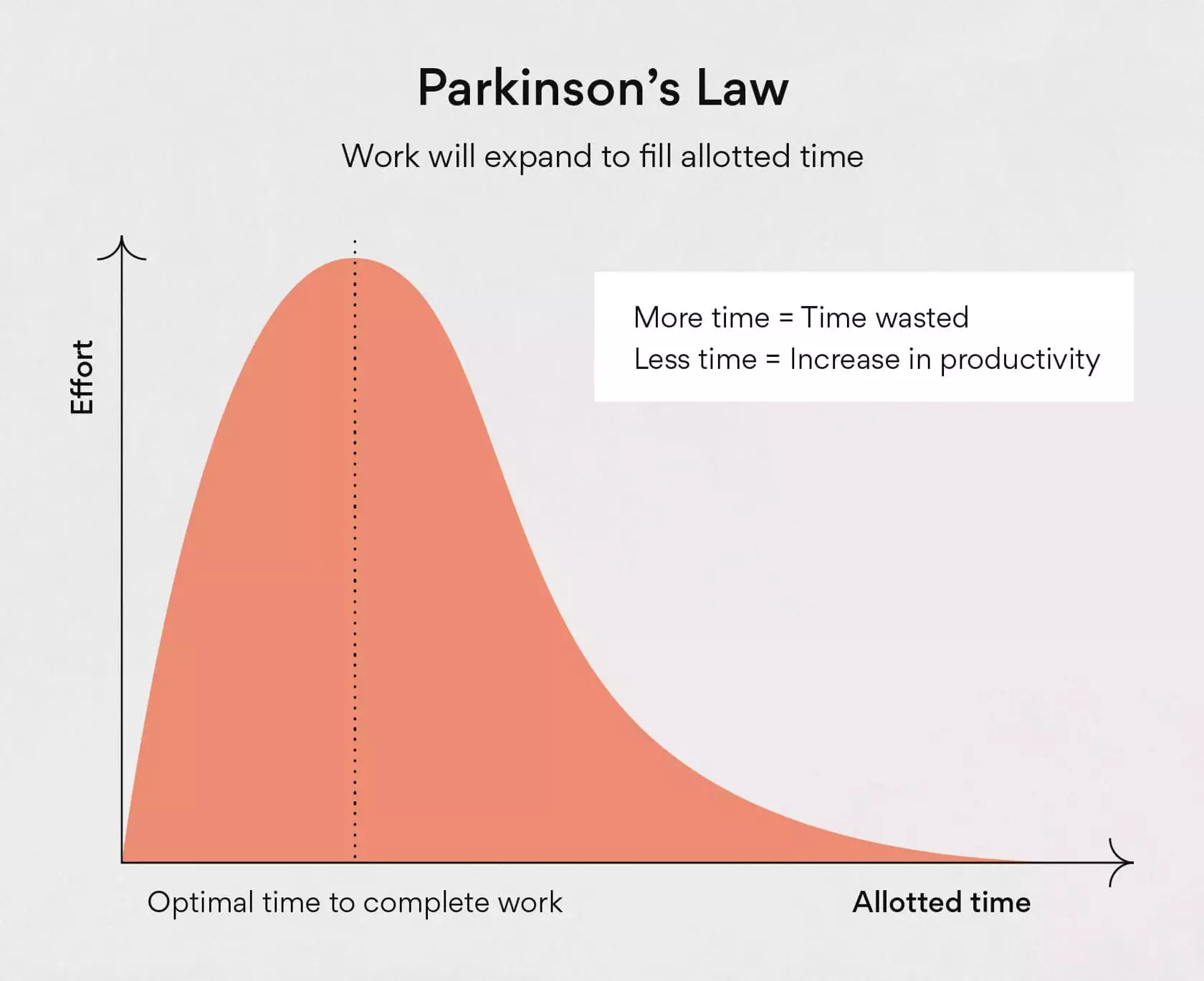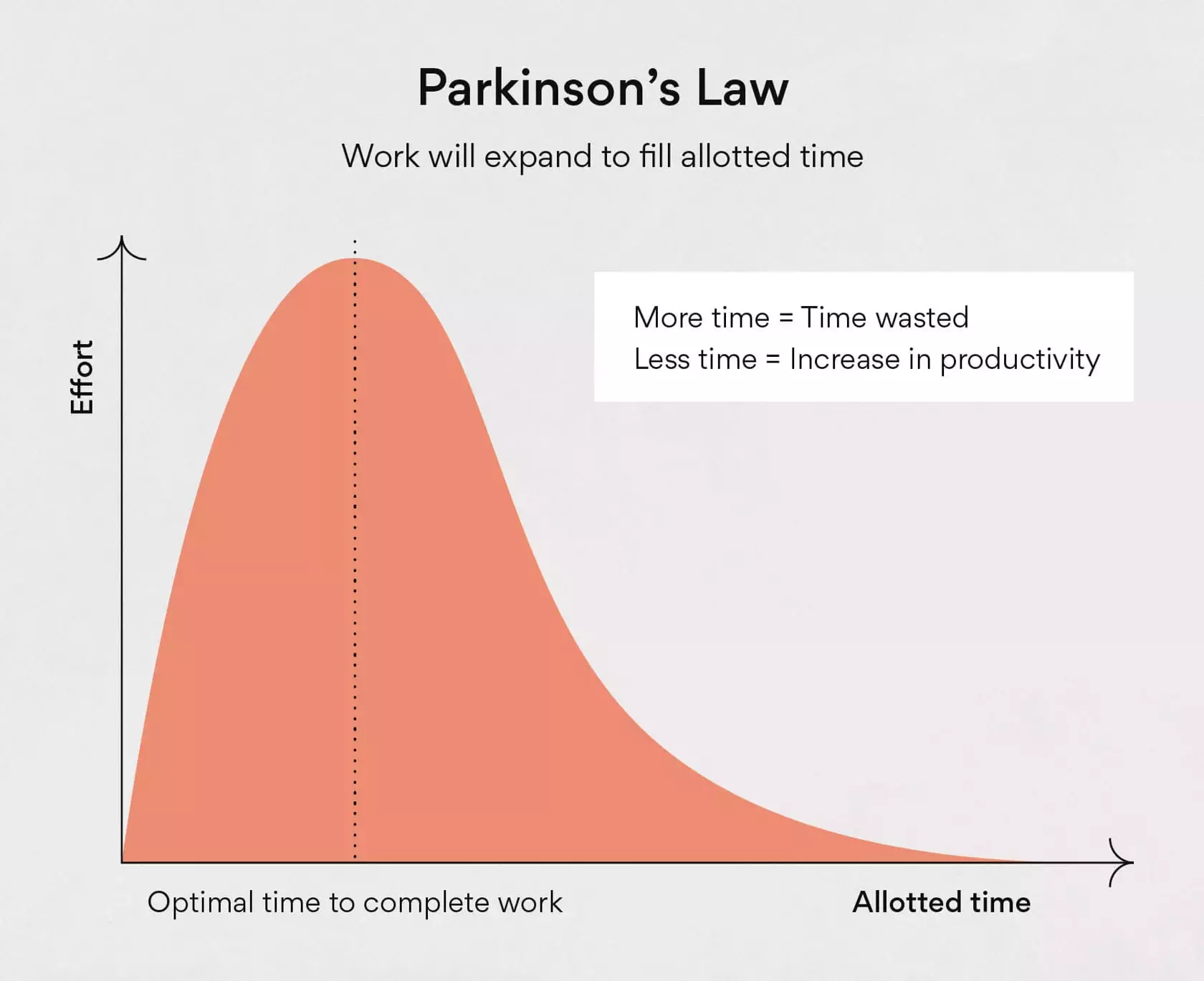Parkinson’s Law: How to overcome it to increase productivity
Parkinson’s Law: How to overcome it to increase productivity
Dr.Abdulrahman ALJAMOUSS
What is Parkinson's Law?
Parkinson’s Law is the idea that your work will expand to fill the time allotted for its completion. This law can come into play when juggling work deadlines or managing projects.

The history of Parkinson’s Law
Cyril Northcote Parkinson was a British naval historian who first introduced Parkinson’s Law in a satirical essay written for “The Economist” in 1955. He then went on to write a book titled, Parkinson’s Law: The Pursuit of Progress. His story in the essay involves a woman whose sole task for the day is to send a postcard.
Because she has the entire day to complete this task, she spends an hour finding the card, half an hour finding her glasses, 90 minutes writing the card, and so forth until she fills her day. His story is meant to explain how work expands to fill the time allotted. While Parkinson’s example may sound extreme, we’ve all experienced this at a smaller scale.
Making the most of Parkinson’s Law
Parkinson’s Law is sometimes misunderstood because of the many corollaries that were created by others. For example, you may have read this one: “If you wait until the last minute, it only takes a minute to do.” The main problem is that it’s simply not true; the second problem is that it can be interpreted as an encouragement for procrastination. Instead, keep on applying some common sense principles.
- Set reasonable deadlines.Create enough constraint to unlock your creativity, but be realistic. There is no point trying to work on something that should take a couple of days in a couple of hours. Trying to be more productive will not magically turn you into a superhuman.
- Make sure you take the deadlines seriously. Announcing it to a friend or colleague is a great way to create artificial pressure so you stick to your deadline. Having another artificial constraint such as a meeting, a call, a gym session or anything else afterwards also works.
- Review and iterate.It can take a bit of trial and error to figure out how much time you can save by using Parkinson’s Law. After you’re done with a task, take a few minutes to reflect. How did it feel? Did I manage to get it done? Could I have finished quicker? Use metacognition strategies to get better over time.
Even though it wasn’t its original intended purpose, along with basic time management technique, Parkinson’s Law can do wonders for your productivity and your creativity.
Overcoming Parkinson's Law
- Plan your work strategically.
- Set self-imposed deadlines.
- Try timeboxing.
- Try the Pomodoro Technique.
- Use task management tools.
How to Avoid Falling Victim to Parkinson’s Law
Parkinson’s law isn’t a magic formula or a fixed rule. But it is an observation you can use to help you become more productive. Some strategies that can help you make the most of your time without falling victim to Parkinson’s law include.
Plan Your Time Carefully
When you have a lot of time to complete a task, it’s easy to push it off until later. But if you plan your time carefully and set deadlines for yourself, you can avoid falling into the procrastination trap.
Write Down Your Goals
Whatever your goal happens to be, write it down. Track your progress by regularly checking in and noting the progress you've made, what still needs to be done, and whether your final goal has changed at all over the course of the project.4
This type of reflective goal-tracking not only helps keep you accountable, but it can also help you better visualize your progress, your remaining work, and whether or not the project is appearing more daunting than it really is.
Set Realistic Deadlines
Avoid setting arbitrary deadlines and instead focus on how long each aspect of the project actually takes. Instead, think about how long a task will realistically take to complete. While this might not always be clear, consider past experiences as a guide. Instead of focusing on a date in the future when the task must be done by, think about how soon you can get it done and out of your way.
When you have a clear understanding of how long a task should take, you can avoid the tendency to expand the work to fill the time you have available.
Prioritize Your Tasks
If you have a lot of tasks to complete, it’s important to prioritize them. By identifying which tasks are most important, you can ensure that you focus on them first and not get bogged down by less important tasks.
Use a Timer
One effective way to avoid Parkinson’s law is to use a timer. When you know that you only have a certain amount of time to complete a task, you’re less likely to expand the work to fill the available time.
Break Tasks Down
Break larger projects into smaller tasks and give yourself self-imposed deadlines throughout the project. When facing a big project, it can often seem more daunting and time-consuming than it actually is. Instead of making progress, you might feel overwhelmed and unsure where to begin.
Chunking is an effective solution that involves breaking up a larger project into smaller, more manageable steps. This strategy can help you work more effectively and may reduce the impact of Parkinson's law by speeding up your progress.5
Take Regular Breaks
When you’re working on a project, it’s important to take regular breaks. This will help you avoid burnout and keep your mind fresh. Try working on a project during your most productive period and take a break when you start to feel distracted or less motivated. Just make sure that you don’t use the break as an excuse to procrastinate.
The Ivy Lee Method to increase productivity
A Profoundly Simple Yet Effective Way to Get More Out of Your To-Do List, By 1918, Charles M. Schwab was one of the richest men in the world.
Schwab was the president of the Bethlehem Steel Corporation, the largest shipbuilder and the second-largest steel producer in America at the time. The famous inventor Thomas Edison once referred to Schwab as the “master hustler.” He was constantly seeking an edge over the competition.
One day in 1918, in his quest to increase the efficiency of his team and discover better ways to get things done, Schwab arranged a meeting with a highly-respected productivity consultant named Ivy Lee.
Lee was a successful businessman in his own right and is widely remembered as a pioneer in the field of public relations. As the story goes, Schwab brought Lee into his office and said, “Show me a way to get more things done.”
“Give me 15 minutes with each of your executives,” Lee replied.
“How much will it cost me,” Schwab asked.
“Nothing,” Lee said. “Unless it works. After three months, you can send me a check for whatever you feel it's worth to you.”

The Ivy Lee Method

During his 15 minutes with each executive, Ivy Lee explained his simple daily routine for achieving peak productivity:
- At the end of each work day, write down the six most important things you need to accomplish tomorrow. Do not write down more than six tasks.
- Prioritize those six items in order of their true importance.
- When you arrive tomorrow, concentrate only on the first task. Work until the first task is finished before moving on to the second task.
- Approach the rest of your list in the same fashion. At the end of the day, move any unfinished items to a new list of six tasks for the following day.
- Repeat this process every working day.
The strategy sounded simple, but Schwab and his executive team at Bethlehem Steel gave it a try. After three months, Schwab was so delighted with the progress his company had made that he called Lee into his office and wrote him a check for $25,000.
A $25,000 check written in 1918 is the equivalent of a $400,000 check in 2015.
The Ivy Lee Method of prioritizing your to-do list seems stupidly simple. How could something this simple be worth so much?
